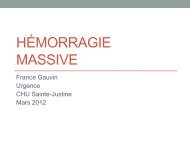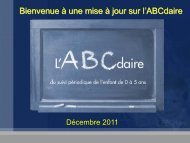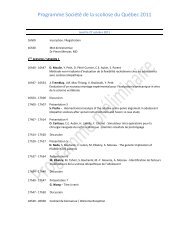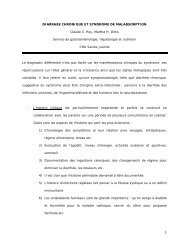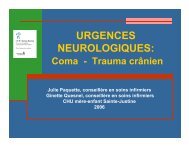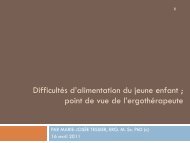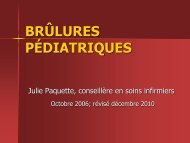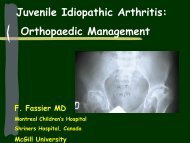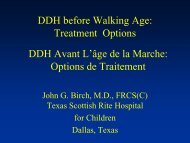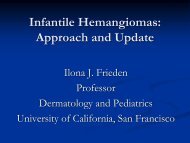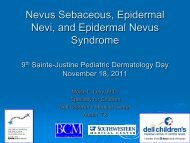atopic dermatitis - CHU Sainte-Justine - SAAC
atopic dermatitis - CHU Sainte-Justine - SAAC
atopic dermatitis - CHU Sainte-Justine - SAAC
- No tags were found...
You also want an ePaper? Increase the reach of your titles
YUMPU automatically turns print PDFs into web optimized ePapers that Google loves.
Overview:What’s New?• Atopic Dermatitis• Filaggrin: Mutations and function• Set up for allergies….???Take me out to the ballgame?Microbes and AD: Battleground!• Staph: Epi vs. Aureus…and MRSA vs. MSSA• Bleach bath, or bottle or canTherapeutics: Teaching, Tricks, TCIs
ATOPIC DERMATITIS• BARRIERDYSFUNCTION• INFECTION• INFLAMMATION• ALLERGY
Mutations in the filaggrin gene:Ichthyosis Vulgaris• Causes ichthyosis vulgaris• Loss-of-function mutations• In Europeans: 1 in 10 mild IV• Total absence of filaggrin– 1 in 400 leads to Severe IV• RISK FACTOR: for <strong>atopic</strong> <strong>dermatitis</strong>and asthma secondary to <strong>atopic</strong> <strong>dermatitis</strong>Smith FJ et al. Nat Genet. 2006;38:337-342.
Filaggrin Mutation Effects• Decreases “NaturalMoisturizing Factor”• Increases permeability• Increases pH– Impacts cell cohesion,permeability and inflammation• Increased risks of asthma, IgE-sensitization,food allergy, rhinitis, persistent AD
FilaggrinInsufficiencyIrvine AD, McLeanI, Leung DYM. NEngl J Med2011;365:1315-27
Filaggrin Mutations: US Data• Long-term study of 6000 mild to modAD children, followed 4 yrs on average• DNA from 850 children• 28% white children (6% Afr-Amer) withFLG mutation• At any time, were 50% less likely to have skin freeof AD symptoms than AD pts without mutations• R501X mutations: higher need for medications forsymptomatic reliefMargolis DJ et al. J Allergy ClinImmunol. 2012 Oct;130(4):912-7
Filaggrin Hypotheses• AD can be triggered by thechronic exposure of barrierdisruptedskin to percutaneousantigens due to abnormalities infilaggrin
Filaggrin Hypotheses: BUT…• Only ?30-50% have FLG mutations,and most outgrow AD• 40% w/ FLG-null alleles: don’t getAD• So…it may not be all filaggrin!Kim BE, Leung DY.Epidermal Barrier in AtopicDermatitis. Allergy AsthmaImmunol Res. 2012Jan;4(1):12-16.
Addressing Barrier Dysfunction• TRADITIONAL APPROACHESAND TARGETED THERAPIES• Moisture after bathing• Emollients liberally• Targeted barrier repair products• Part of maintenance care, and primaryintervention for mild AD in infants
Prevention of Atopic Dermatitis• Large Cochraine Review– Nothing yet! (Formula, diet,allergen avoidance)• EARLY SKIN CARE– Can we get around the barriermutation effects?
GET THEM BETTERPractical Methods of TCS Use• “As low as you can go (or just above wherethey were)”• “Stronger steroids” to start, with tapering toless potent CS as AD improves– Stepwise model for as-needed management asdisease approves• More prolonged use of less-potent preparations• “Mix and match” of TCS and non-steroidtopicals Krakowski AC, Eichenfield LF, Dohil MA. Pediatrics2008;122:812-824
STEROID PHOBIA:• 72.5% of parents worried aboutTCS on child's skin• 24% admitted to not usingmedicines because of the worriesCharman CR, Morris AD, Williams HC. Br J Dermatol. 2000;142(5):931-6
Topical Corticosteroids (TS)• Low-potency TS: Safe for shortterm use• Seven classes: mild to superpotent• Are there concerns with their use?– YES! ESPECIALLY withMORE potent TS and/orLONG-TERM USE
Didn’t get better• ASSESS QUANTITY OF USE!• Consider infection/anti-staph rx• Antihistamines (poor evidencebasis, but….)• Higher potency CS and/or Wetwraps• Return visit in not too long
Wet wrap dressings with TCS:Effective rapid control of severe AD• 218 pediatric patients, hospitalized• Mean age app 6 yrs (2 mths-17 years)• Mean duration of 3.61 days (range 1-16)• All patients showed improvement– 45%: 75 to 100% improvement– 38%: 50 to 75% improvement– 6%: 25 to 50% improvementDabade TS, Davis DM et al. J Am Acad Dermatol 2012;67:100-6
Better, but not great…orpersistent, frequently flaring• Ask about feeding practices, <strong>atopic</strong> history• Establish aggressive maintenance plan– Intermittent CS and/or TCIs– Assess sleep and itching as endpoints– Consider anti-infectives, bleach baths/products– ?Trials of TBRP (targetted barrier repair products)and/or emollients• PEARL: Check growth, infection history,differential diagnosis• Consider allergy referral
TCI Safety Information:FDA Pediatric Advisory CommitteeMeeting; May, 2011• Clinical studies– Pimecrolimus Infant 3 year march; 5-yearsafety Registries• Epidemiology studies– 5 studies• Data Safety Monitoring Boards: US/Global• Post-marketing Surveillance /AdverseEvent Reporting System19
TCI: Systematic Review ofEpidemiologic Studes– Epidemiological studies up to April 2010,conducted in a variety of populations– No evidence of increased risk of lymphomasoverall or specific sub-types– No evidence indicating that melanoma or nonmelanomaskin cancer is associated withtopical TCI use– But insufficient evidence to end all concernsTennis, Gelfand et al. Br J Derm 2011
MRSA and Atopic Dermatitis• Atopics: Lower rates of MRSAinfection than communityacquiredstaph infections• Ecologic perspective: “DoesMSSA protect against MRSA?”Suh et al. Ped Derm 2008;25:528-34Matiz C et al. Ped Derm 2011:28:6
Bleach Baths…a little history• Joseph Lister: pioneered antiseptic solutions toclean surgical instruments and irrigate woundswith primarily phenol• Henry Dakin, British chemist and Frenchsurgeon Alexis Carrel developed Carrel-Dakinmethos of irrigating wound’s with Dakin’ssolution, 0.4 to 0.5 % sodium hypochlorite and4% boric acid– Has been used since WW I• Popularized for use with EB (McGuire)..now AD
Mechanisms of Bleach• Reacts with DNA,RNA, fatty acids,cholesterol, lipids,proteins• Additionally, theincreased pH isharmful to cells(HOCL)• Specifics:– 1) Reaction with proteinsulfhydryl groups 1– 2) reaction with proteinamino groups(chloramination-AAdecompose) 1– 3) oxidative unfoldingand aggregation ofproteins (heat shockprotein 33) 2Estrela et al, Braz Dent J, 2002:13: 113-117Winter et al., Cell, 2008; 135:691-701
Bleach Dilutions (6%)Sodium Cups Bathtub (40-60gallon)Hypochlorite (%)0.009% (90 ppm) ¼ cup ¼ tub0.019% (190 ppm) ½ cup ¼ tub0.005% (50 ppm) ¼ cup ½ tub0.009% (90 ppm) ½ cup ½ tub0.005% (50 ppm) ½ cup Full tub5-10 minutes, 2-3 times/wk Infant tub: 1-2 tsp/gallonBathtub: 40-60 gallons; 1 gallon = 128 oz, 40 gallons = 5120 oz; 1 cup = 8 ozSwimming pool reference: 3 parts per million (available chlorine)
Bleach baths and alternatives• ¼ to ½ cup for ½ to full tub of standardbleach (6%).– 1/2 cup for 40 gallon full tub is 0.005%concentration• Na Hypochlorite body wash (CLn BodyWash)• Dilute Na hypochlorite and hypochlorous acid(Aurstat: marketed with Hyl<strong>atopic</strong>Plus);Microcyn-based antipruritic hydrogel and dermalssprays (Atrapro)
CID 2011:52 ( FebruaClinical Practice Guidelinesby the Infectious Diseases Society of America for the Treatment ofMRSA Infections in Adults and Children:Executive Summary• Decolonization strategies should be offered inconjunction with ongoing reinforcement of hygienemeasures and may include the following:– i. Nasal decolonization with mupirocin twice daily for 5–10 days(C-III).– ii. Nasal decolonization with mupirocin twice daily for 5–10days and topical body decolonization regimens with a skinantiseptic solution (eg, chlorhexidine) for 5–14 days or dilutebleach baths.• For dilute bleach baths, 1 teaspoon per gallon of water [or ¼ cupper ¼ tub or 13 gallons of water given for 15 min twice weekly for3 months can be considered.)
Eczema and ImmuneDeficienciesHyper-Ig E Syndrome• AD, High IgE, eosinophilia• Abscesses (S aureus)• Pneumonia, Pneumatoceles• Skeletal - Bone fractures, Scoliosis(highly specific)MUTATION: STAT 3JACI 2010:126:211
Eczema andImmunodeficencyDock8 mutations• AR, High IgE, eosinophilia– recurrent viral infections (chronic HSV,Molluscum contagiosum), CNS.– No bone/connective tissue problems• Dysregulated IL17 expression, leadingto problems with T-cell activationJACI 2010:126:211
Your nephew has no peanut allergy andyou take him to the game. He seems boredand distracted, and has problems payingattention. You should think…A. My oh my. He may have attentiondeficit disorderB. Oh, I bet he is itchyC. I wonder if he is getting hydroxyzineand that is making him sleepyD. It’s baseball. It is a pretty boring game!
Comorbidities and Atopic Dermatitis• Mental Health Issuess appear more common– Attention Deficit Disorder in youngerchildren• “Dose-dependent” relationship betweenseverity prevalence of AD (90,000 children)– ?Autism risk– Depression: teens and adults.– No evidence to mandate screening, but to beconsideredSchmitt J et al. JAMA 2009;30:724-6Yaghmale P..Simpson EL et al. J Invest Dermatol 2011:131:S41
FOOD ALLERGY ANDECZEMA• Children: 17-40% rate of at least oneclinically-relevant food allergy• But food allergy MAY NOT BE ADTRIGGER!• Skin prick & Spec IgE have poor predictivevalue– (e.g. Milk: 238 of 1000 tested will have false+ vs 50 having clinically relevant allergy)Boyce JA et al. J All Clin Immunol. 2010 Dec;126(6 Suppl):S1-58Sicherer SH, Wood RA et al. Pediatrics 2012;129:193-7
What else is new inAllergy and Eczema• Preventing allergies through diet: NOPE!– 50,000 children study: prolonged exclusivebreastfeeding did not reduce risk of eczema• For children with milk allergy, extensivelyheated foods (e.g. muffins) may be toleratedand ingesting may speed tolerance to wholemilk.
Derm-Relevant Highlights fromthe Guidelines• “suggest that children less than 5 years ofage with moderate to severe AD beconsidered for FA evaluation for milk, egg,peanut, wheat, and soy, if at least one ofthe following conditions is met:– The child has persistent AD in spite of optimizedmanagement and topical therapy.– The child has a reliable history of an immediatereaction after ingestion of a specific food.J Allergy Clin Immunol. 2010 Dec;126(6 Suppl):S1-58
Compliance/Adherence Tools• Discussion of steroid strengths andsafety• Prescribe specific amounts initially• Educational and Instructional materialsmatter– Handouts, Web-sites, Video training modules• Follow-up soon!eczemacenter.orgeczemahelp.ca
NO ANGST!Integrating Evolving Therapy• Great skin care• Anti-inflammatory medication as needed, withmost care as topical regimens• Maintenance care “as needed”• Keep regimens simple• Educate…in the office, on the net, wherever!• If really hard, seek help!
Thank you…and come visit us inSan Diego!
If you want even more Peds Derm!Pediatric Dermatology for the PractionerApril 5 and 6, 2013Hilton Torrey Pines



